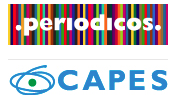Strategies for achieving affective objectives in remote education
DOI:
https://doi.org/10.35699/2237-5864.2020.24493Keywords:
Affective goals, Remote teaching, Hybrid teaching, Pandemic, Covid-19Abstract
This work was motivated by the wide use of videoconferencing as an alternative to face-to-face classes due to the pandemic caused by Covid-19. It can be characterized as a theoretical essay that aims to discuss the effectiveness of remote teaching to achieve affective learning objectives. The most easily achieved objectives through expository classes – and consequently through videoconferences – are cognitive, notably at the levels of memorization and understanding. When learning objectives are in the affective domain – which involve emotions, feelings and attitudes – other strategies are required. Thus, based on the contribution of theorists in the field of learning objectives and the results of empirical research, the possibilities of using different strategies are discussed through online course platforms. Strategies for reflective discussion, collaborative work, verbalization group/observation group, peer tutoring, dramatization, symposium, seminar and gamification are discussed. The study points to the adoption of hybrid education as the preferred form of higher education in the post-pandemic scenario, but which must be accompanied by the training of teachers in the use of group teaching strategies.
Downloads
References
AKOS, Patrick; KRETCHMAR, Jen. Investigating grit at a non-cognitive predictor of college success. The Review of Higher Education, Baltimore, v. 40, n. 2, p. 163-186, 2017. Disponível em: https://muse.jhu.edu/article/640608. Acesso em: 06 ago. 2020. DOI: https://doi.org/10.1353/rhe.2017.0000.
ANDERSON, Lorin W. et al. A taxonomy for learning, teaching, and assessing: A revision of Bloom's taxonomy of educational objectives. Essex: Longman, 2001.
BAKER, Ryan Shaun J. D. et al. Better to be frustrated than bored: The incidence, persistence, and impact of learners’ cognitive–affective states during interactions with three different computer-based learning environments. International Journal of Human-Computer Studies, Amsterdã, v. 68, n. 4, p. 223-241, 2010. Disponível em: https://www.sciencedirect.com/science/article/abs/pii/S1071581909001797. Acesso em: 06 ago. 2020. DOI: https://doi.org/10.1016/j.ijhcs.2009.12.003.
BERGMANN, Jonathan. Sala de aula invertida. São Paulo: Grupo Gen-LTC, 2016.
BIRBECK, David. Graduate qualities and the affective domain: New horizons to explore. 2009. Tese (Doutorado em Educação) – Learning and Teaching Unit, University of South Australia, Adelaide, 2009.
BLOOM, Benjamin Samuel et al. Taxonomy of educational objectives: the classification of educational goals: handbook I: cognitive domain. Nova Iorque: D. Mckay, 1956.
BOBBITT, John Franklin. How to Make a Curriculum. Boston: Houghton Mifflin, 1924.
BOLIN, Aaron U.; KHRAMTSOVA, Irina; SAARNIO, David. Using student journals to stimulate authentic learning: balancing Bloom's cognitive and affective domains. Teaching of Psychology, Oxfordshire, v. 32, n. 3, p. 154-159, 2005. Disponível em: https://www.tandfonline.com/doi/abs/10.1207/s15328023top3203_3. Acesso em: 06 ago. 2020. DOI: https://doi.org/10.1207/s15328023top3203_3.
CATE, Olle Ten; DE HAES, Hanekke (JCJM). Summative assessment of medical students in the affective domain. Medical Teacher, [S.l], v. 22, n. 1, p. 40-43, 2000. DOI: https://doi.org/10.1080/01421590078805.
CLEVELAND-INNES, Martha; ALLY, Mohamed. Learning to feel: Education, affective outcomes and the use of online teaching and learning. European Journal of Open, Distance and E-learning, Berlim, v. 10, n. 2, p. 1-17, 2007. Disponível em: https://www.eurodl.org/?p=archives&year=2007&halfyear=2&..&abstract=285. Acesso em: 06 ago. 2020.
D'MELLO, Sidney; GRAESSER, Art. Dynamics of affective states during complex learning. Learning and Instruction, Amsterdã, v. 22, n. 2, 145-157, 2012. Disponível em: https://www.sciencedirect.com/science/article/abs/pii/S0959475211000806. Acesso em: 29 set. 2020. DOI: https://doi.org/10.1016/j.learninstruc.2011.10.001.
DU BOULAY, Bento. Projetando interação educacional afetiva e cognitiva. In: LUCKIN, Rosemary et al. Handbook of Design in Educational Technology. Nova Iorque: Routledge, 2013. p. 168-175. Disponível em: encurtador.com.br/Fagms. Acesso em: 06 ago. 2020.
ECCLESTONE, Kathryn; HAYES, Dennis. Afetar: conhecimento, comunicação, criatividade e emoção. 2008. Disponível em: https://www.researchgate.net/publication/265454681_The_Dangerous_Rise_of_Therapeutic_Education. Acesso em: 06 ago 2020. DOI: https://doi.org/10.4324/9780203870563.
FALOUT, Joseph; ELWOOD, James; HOOD, Michael. Demotivation: Affective states and learning outcomes. System, Amsterdã, v. 37, n. 3, p. 403-417, 2009. Disponível em: https://www.sciencedirect.com/science/article/abs/pii/S0346251X09000566. Acesso em: 06 ago 2020. DOI: https://doi.org/10.1016/j.system.2009.03.004.
FASSO, Wendy; KNIGHT, Bruce Allen. Afetam no aprendizado on-line: resultados, emoções e estados afetivos. In: Aplicações Inovadoras de Pedagogia Online e Design de Cursos. Hershey: IGI Global, 2018. p. 128-153.
GIL, Antonio Carlos. Metodologia do ensino superior. São Paulo: Atlas, 2020.
GREENWOOD, Charles R.; CARTA, Judith J.; HALL, R. Vancel. The Use of Peer Tutoring Strategies in Classroom Management and Educational Instruction, School Psychology Review, Londres, v. 17, n. 2, 258-275, 1988. DOI: https://doi.org/10.1080/02796015.1988.12085342.
GRIFFIN, Lynda; ROY, James. A great resource that should be utilised more, but also a place of anxiety: student perspectives on using an online discussion forum. Open Learning: The Journal of Open, Distance and e-Learning, Londres, p. 1-16, 2019. DOI: https://doi.org/10.1080/02680513.2019.1644159.
GRONLUND, Norman E. How to write and use instructional objectives. Englewood Cliffs: Merrill/Prentice-Hall, 1995.
HOMER, Bruce D.; PLASS, Jan L.; BLAKE, Linda. The effects of video on cognitive load and social presence in multimedia-learning. Computers in Human Behavior, Amsterdã, v. 24, n. 3, 786-797, 2008. Disponível em: https://www.sciencedirect.com/science/article/abs/pii/S0747563207000544. Acesso em: 29 set. 2020. DOI: https://doi.org/10.1016/j.chb.2007.02.009.
HORN, Michael B.; STAKER, Heather. Blended: usando a inovação disruptiva para aprimorar a educação. Porto Alegre: Penso, 2015.
JAGGER, Suzy. Affective learning and the classroom debate. Innovations in Education and Teaching International, Londres, v. 50, n. 1, p. 38-50, 2013. Disponível em: https://srhe.tandfonline.com/doi/abs/10.1080/14703297.2012.746515. Acesso em: 06 ago. 2020. DOI: https://doi.org/10.1080/14703297.2012.746515.
JOHNSON, David W.; JOHNSON, Roger T. Fazendo funcionar a aprendizagem cooperativa. Teoria em prática, [S.l.], v. 38, n. 2, p. 67-73, 1999.
KRATHWOHL, David R.; BLOOM, Benjamin S.; MASIA, Bertram B. Taxonomy of educational objectives, handbook ii: affective domain. Nova Iorque: David McKay Company, 1964.
LEE, Cheng-Yuan. Student motivation in the online learning environment. Journal of Educational Media & Library Sciences, Taiwan, v. 37, n. 4, p. 367-375, 2000. Disponível em: http://joemls.dils.tku.edu.tw/fulltext/37/37-4/367-375.pdf. Acesso em: 06 ago. 2020.
LYNCH, Sandra; HART, Bethne; COSTA, Catherine M. Giving voice to values: An undergraduate nursing curriculum project. Collegian, Palo Alto, v. 21, n. 4, p. 367-373, 2014. Disponível em: https://www.sciencedirect.com/science/article/abs/pii/S1322769613000929. Acesso em: 06 ago. 2020. DOI: https://doi.org/10.1016/j.colegn.2013.09.004.
MAGER, Robert F. Preparing instructional objectives. Palo Alto: Fearon Publishers, 1962. Disponível em: https://eric.ed.gov/?id=ED018143. Acesso em: 29 set. 2020.
MAJURI, Jenni; KOIVISTO, Jonna; HAMARI, Juho. Gamification of education and learning: A review of empirical literature. In: GAMIFIN 2018, 2., 2018. Pori. Proceedings of the 2nd international GamiFIN conference. Pori: CEUR-WS, 2018. p. 11-19. Disponível em: https://trepo.tuni.fi/bitstream/handle/10024/104598/gamification_of_education_2018.pdf. Acesso em: 29 set. 2020.
MARTIN, Barbara L.; BRIGGS, Leslie J. The affective and cognitive domains: Integration for instruction and research. Nova Jérsei, Educational Technology, 1986. Disponível em: encurtador.com.br/jtFIU. Acesso em: 06 ago. 2020.
MARTIN, Florence; PARKER, Michele A. Use of synchronous virtual classrooms: Why, who, and how. MERLOT Journal of Online Learning and Teaching, Long Beach, v. 10, n. 2, p. 192-210, 2014.
MOORE, Schuster M. Theory of transactional distance. In: KEEGAN, Desmond. (ed.), Theoretical principles of distance education. Nova Iorque: Routledge, 1997. p. 22-38.
MOORE, Michael G.; KEARSLEY, Gres. Educação a distância: sistemas de aprendizagem on-line. São Paulo: Cengage Learning, 2013.
MORENO, Jacob Levy. Fundamentos do psicodrama. São Paulo: Summus, 1983.
NORTHEY, Gavin et al. Increasing student engagement using asynchronous learning. Journal of Marketing Education, Londres, v. 37, n. 3, p. 171-180, 2015. DOI: https://doi.org/10.1177/0273475315589814.
OLATUNJI, Michael Olalekan. Online Education: Issues, Challenges and Implications. Khazar Journal of Humanities & Social Sciences, Baku, v. 16, n. 3, 2013. Disponível em: https://jhss-khazar.org/wp-content/uploads/2010/04/0005KHAZAR_Journal_of_Humanities_and_Social_Sci_ences1.pdf. Acesso em: 06 ago. 2020.
SEELS, Barbara; GLASGOW, Zita. Exercises in instructional design. Columbus: Merrill Publishing Company, 1990.
SHOFFNER, Melanie. The place of the personal: Exploring the affective domain through reflection in teacher preparation. Teaching and Teacher Education, Amsterdã, v. 25, n. 6, p. 783-789, 2009. Disponível em: https://www.sciencedirect.com/science/article/abs/pii/S0742051X08002011. Acesso em: 06 ago 2020. DOI: https://doi.org/10.1016/j.tate.2008.11.012.
SHORT, John; WILLIAMS, Ederyn; CHRISTIE, Bruce. The social psychology of telecommunications. [S.l.]: John Wiley & Sons, 1976.
SNELSON, Chareen; ELISON-BOWERS, Patt R. Using YouTube videos to engage the affective domain in e-learning. In: MENDEZ-VILAS; Antonio et al. Research, Reflections and Innovations in Integrating ICT in Education. Badajoz: Formatex, 2009. p. 1481-1485. Disponível em: https://scholarworks.boisestate.edu/edtech_facpubs/50/. Acesso em: 06 ago. 2020.
TYLER, Ralph W. Basic principles of curriculum and instruction. Chicago: University of Chicago Press, 1949.
VAN DER HOEVEN KRAFT, Katrien J. et al. Engaging students to learn through the affective domain: A new framework for teaching in the geosciences. Journal of Geoscience Education, Northfield, v. 59, n. 2, p. 71-84, 2011. Disponível em: https://www.tandfonline.com/doi/abs/10.5408/1.3543934a. Acesso em: 06 ago. 2020. DOI: https://doi.org/10.5408/1.3543934a.
WHITE, Karl R. T-groups revisited: Self-concept change and the "Fish-Bowling" technique. Small Group Behavior, Pensilvânia, v. 5, n. 4, p. 473-485, 1974. DOI: https://doi.org/10.1177/104649647400500407.

Downloads
Published
How to Cite
Issue
Section
License
Copyright (c) 2020 Antonio Carlos Gil, Arquimedes Pessoni

This work is licensed under a Creative Commons Attribution 4.0 International License.
Authors who publish in this journal retain the copyright and grant the journal the right of first publication, with the work simultaneously licensed under the Creative Commons Attribution License which allows the sharing of work with acknowledgment of authorship and initial publication in this journal.
Authors are authorized to take additional contracts separately, for non-exclusive distribution of the version of the work published in this journal (e.g. publish in institutional repository or as a book chapter), with acknowledgment of authorship and initial publication in this journal.
Open access policy:
Revista Docência do Ensino Superior is an Open Access journal, which means that all content is available free of charge, at no cost to the user or their institution. Users may read, download, copy, distribute, print, search, or link to the full texts of the articles, or use them for any other legal purpose, without seeking prior permission from the publisher or author, provided they respect the license to use the Creative Commons used by the journal. This definition of open access is in line with the Budapest Open Access Initiative (BOAI).























